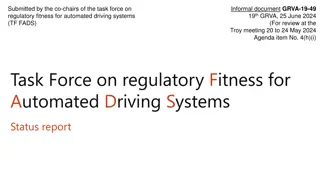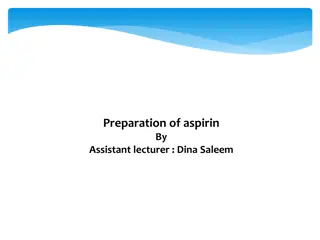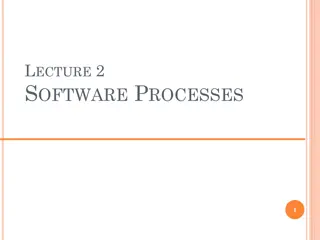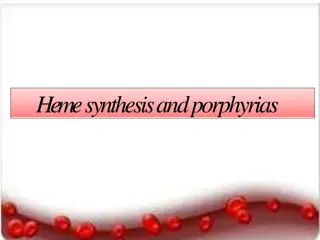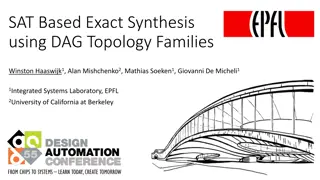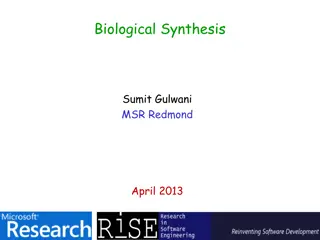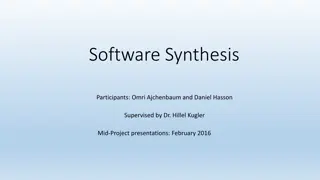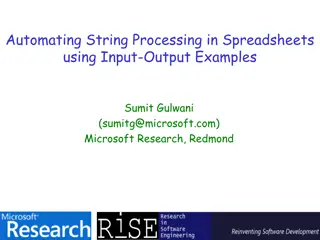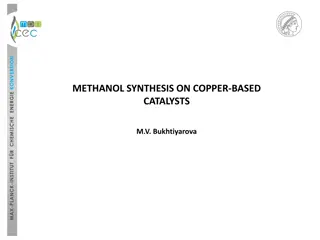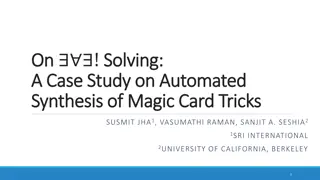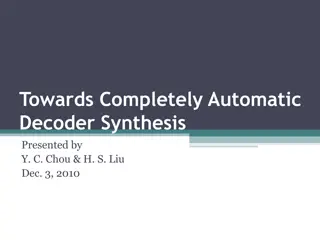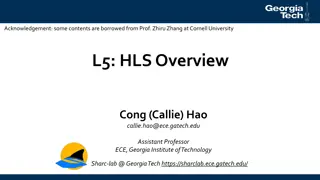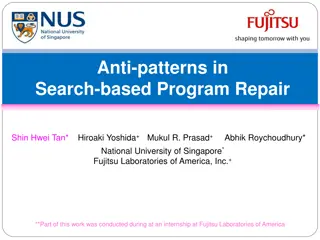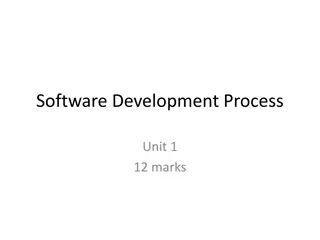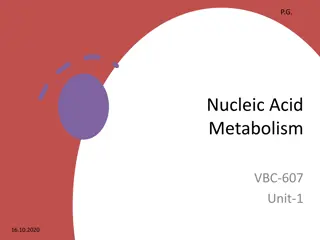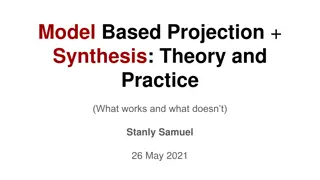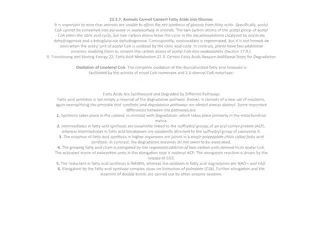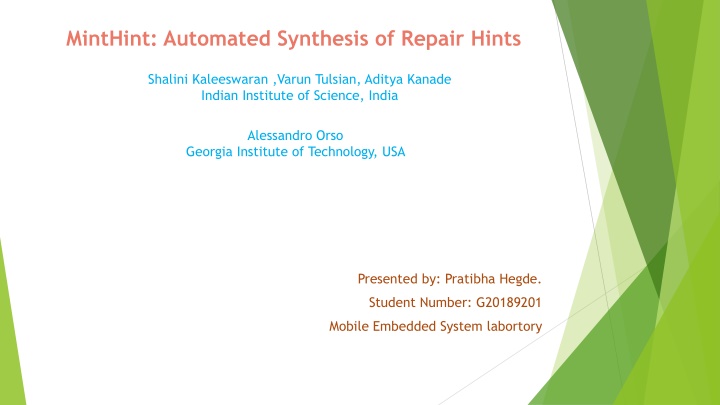
MintHint: Automated Synthesis of Repair Hints
MintHint is a novel technique for program repair that utilizes statistical correlation analysis and pattern-matching synthesis to generate repair hints, enhancing developers' productivity during debugging tasks. It departs from traditional fully automated repair approaches and focuses on providing valuable suggestions for rectifying faulty statements. The user study and evaluation on Unix utilities demonstrate MintHint's effectiveness in various scenarios, even with incomplete operational specifications.
Download Presentation

Please find below an Image/Link to download the presentation.
The content on the website is provided AS IS for your information and personal use only. It may not be sold, licensed, or shared on other websites without obtaining consent from the author. If you encounter any issues during the download, it is possible that the publisher has removed the file from their server.
You are allowed to download the files provided on this website for personal or commercial use, subject to the condition that they are used lawfully. All files are the property of their respective owners.
The content on the website is provided AS IS for your information and personal use only. It may not be sold, licensed, or shared on other websites without obtaining consent from the author.
E N D
Presentation Transcript
MintHint: Automated Synthesis of Repair Hints Shalini Kaleeswaran ,Varun Tulsian, Aditya Kanade Indian Institute of Science, India Alessandro Orso Georgia Institute of Technology, USA Presented by: Pratibha Hegde. Student Number: G20189201 Mobile Embedded System labortory
Abstract Introduction Overview Algorithm Evaluation User study Conclusion and Future Work
Abstract In this paper, we present MintHint, a novel technique for program repair that is a departure from most of today s approaches. Instead of trying to fully automate program repair, which is often an unachievable goal, MintHint performs statistical correlation analysis to identify expressions that are likely to occur in the repaired code and generates, using pattern-matching based synthesis, repair hints from these expressions. Intuitively, these hints suggest how to rectify a faulty statement and help developers find a complete, actual repair. The first part is a user study that shows that, when debugging, developers productivity improved many fold with the use of repair hints instead of traditional fault localization information alone. The second part consists of applying MintHint to several faults in Unix utilities to further assess the effectiveness of the approach. Our results show that MintHint performs well even in common situations where(1)there pair space searched does not contain the exact repair, and (2) the operational specification obtained from the test cases for repair is incomplete or even imprecise, which can be challenging for approaches aiming at fully automated repair.
Introduction In recent years, there has been a growing interest in automated program repair techniques. Although these techniques have been shown to be effective, they suffer from one or more of the following limitations. First, some techniques rely on the existence of a specification for the program being debugged, which is rarely the case in practice. Second, techniques that do not rely on specifications tend to overfit the repair to the set of existing test cases, which is likely to affect the general validity of the repair. Third, because they are looking for a complete repair, most existing techniques must perform a search over a repair space that is large enough to include the (unknown) repair. For non-trivial repairs, this can make the technique either ineffective (if the bound on the repair space used by the tool is too small) or too expensive to be used in practice (if the bound on the repair space used/required is too large). To address these limitations of existing techniques, in this paper we propose MintHint, a novel, semi-automated approach to program repair. MintHint is a departure from most of today s program repair techniques as it does not try to find a complete repair, which we have observed to be an unachievable goal in many, if not most, cases due to technical and practical reasons. Instead, MintHint aims to generate repair hints that suggest how to rectify a faulty statement and help developers find a complete, actual repair
Replace s[*i] == ENDSTR by s[*i+1] == ENDSTR In the more general case, hints are not necessarily complete repairs, but rather practically useful suggestions on how to generate such repairs.
MintHint operates in four steps. The first step identifies potentially faulty statements by leveraging an existing fault localization technique that requires only a test suite. The subsequent steps are performed for each of the identified statements. The second step derives a state transformer, that is, a function that (1) Is defined for all program states that reach the faulty statement in the given test suite (2) Produces the right output state for each of them. This step leverages dynamic symbolic execution The third step explores a repair space and tries to identify and rank, through a statistical correlation analysis, expressions in the space that are likely to occur in the repaired statement, using the state transformer derived earlier. The fourth step of the approach synthesizes repair hints by pattern matching the expressions computed in the previous step with those in the faulty statement. Finally, after computing hints for all potentially faulty statements, MintHint ranks the generated hints to help developers prioritize their efforts
MintHint synthesizes five types of hints that suggest (1) insertion, (2) replacement, (3) removal, or (4) retention of expressions, and (5) combinations of these. As shown in Table 1, these hints are applicable to many types of common faults, including incorrect, spurious, or missing expressions, and combinations of these. Moreover, MintHint can handle faults in a variety of program constructs, such as assignments, conditionals, switch statements, loop headers, return statements, and statements with ternary expressions. MintHint s main restriction is that the fault has to involve a single statement and, in the case of an assignment, it must be in the righthand side expression.
MintHint overcomes the limitations of existing techniques, which we listed earlier, in the following ways. First, it does not rely on a formal specification; it instead derives an operational specification(i.e., a state transformer) from the test cases available. Second, approaches that aim at deriving complete repair typically use equality with the state transformer (or an analogous entity) as a criterion for selecting a candidate repair. The statistical correlation used in MintHint is a more relaxed and robust notion than equality and can thus be more effective in identifying which expressions are likely to be part of the repaired code; this allows MintHint to synthesize more general repairs and to be effective in the presence of incomplete data or even imperfect data (i.e., state transformer mappings that do not arise in execution of the fault- free program). Third, since MintHint looks for building blocks of repair (rather than the complete repair itself) and then combines them algorithmically to generate compound hints, it can generate useful, actionable hints even when exploring an incomplete repair space.
In summary, the main contributions of this paper are: The definition of MintHint, a novel sophisticated program repair technique that suitably combines symbolic, statistical, and syntactic reasoning and overcomes some of the main limitations of existing techniques by focusing on generating repair hints, rather than complete repairs. An implementation of MintHint that can perform automated synthesis of repair hints for C programs. A user study that evaluates the usefulness of repair hints during debugging.. A further evaluation of MintHint s effectiveness on several faulty versions of three real- world programs.
Overview MintHint takes as input a faulty program and a test suite, where at least one test case triggers the fault in the program, and thus fails and produces a list of repair hints in four steps. Step 1: Fault localization. This is a preliminary step, whose goal is to provide the hint generation algorithm with a list of possibly faulty statements to be repaired. To compute this list, MintHint can leverage any existing fault localization approach. In our current implementation, we use the Ochiai approach as implemented in the Zoltar tool which performs spectra-based fault localization. Step 2: Derivation of state transformers. Informally, this state transformer is a function that, given an input state (i.e.,valuation to variables) at the (potentially) faulty statement, produces an output state that would make every test in the test suite pass, including the failing ones. For passing tests, state transformers can be easily computed by simply observing input and output states during the execution of the tests. MintHint computes state transformers using dynamic symbolic execution and constraint solving.
Table 2 shows some entries in the state transformer of the newly created assignment statement: (1) the string array s and index expression *i in the input state and (2) the left hand side (LHS) variable branch0 in the output state. The values of all variables except branch0 remain unchanged between a pair of input/output states, and hence are not shown again. The value of branch0 in the first row is obtained from a passing test by concrete execution, whereas the remaining values are obtained from failing tests using symbolic execution. Step 3: Ranking of expressions. The goal of this step is to identify syntactic building blocks (i.e., expressions) for constructing an RHS expression compliant with the computed state transformer. To do so, MintHint searches the solution space, called the repair space, for expressions whose values over the input state of the state transformer are statistically correlated with the corresponding output values produced by the state transformer. More precisely, MintHint interprets correlation coefficients, which represent the numerical measure of the strength of a statistical correlation
Step 4: Synthesis of repair hints. After producing a ranked list of expressions, MintHint analyzes this list to synthesize an actionable list of repair hints. MintHint generates two types of hints: simple and compound. A simple hint is a single program transformation, whereas a compound hint is a set of program transformations. For simple hints, MintHint iteratively selects expressions from the repair space of each statement individually, such that (1) their likelihood values are above a given threshold and (2) the statistical correlation among themselves is low. That is, they form a set of expressions such that any one expression in the set is likely to appear in the repaired RHS
simple hints can address faults that can be repaired through a single syntactic transformation, compound hints can help repair more complex faults faults that require either more than one program transformation to be repaired or more refined pattern matching. Further, if the repair space contains only building blocks of the repaired RHS, but not the repaired RHS itself, compound hint obtained by algorithmically combining these building blocks can bring the repair hints closer to the actual repair. At this point, developers can manually apply the hints produced by MintHint by modifying the potential faulty statement according to such hints.
Algorithm MintHint can also handle cases in which the potentially faulty statement is a loop header of the form for(init, cond, upd), where init initializes the loop counter(s), cond is the loop termination condition, and upd is the update of the loop counter(s). In these cases, the fault could be in any of these three components, so MintHint spawns three different tasks for init, cond, and upd
Evaluation Our evaluation consists of two main parts: (1) a user study that assesses whether MintHint can improve developers productivity, and (2) an empirical study in which we apply MintHint to several faulty versions of three Unix utilities to further assess the effectiveness of the approach. Specifically, we investigated the following questions: RQ1: Usefulness of hints Can MintHint produce useful hints, thus enabling developers to repair programs more effectively? RQ2: Robustness How does MintHint perform when the repair space is incomplete (i.e., does not contain the repaired version of the faulty expression) and is supplied imprecise data? RQ3: Performance and scalability How well does MintHint scale to large programs, state transformers, and repair spaces?
User study Experimental Setup. We performed fault localization on a set of programs from the Siemens suite , which consists of programs with multiple faulty versions. Table 5 lists the programs and the number of faulty versions that were selected as tasks In the control phase, the users were given the fault localization information and the test suite. In the experimental phase they were also given the repair hints. Each user worked on a single task per phase and was given 2h to complete that task. We considered a task to be complete if the repaired program passed all the tests.
(RQ1) Usefulness of hints. Table 7 summarizes the results of the user study. In the control phase (i.e., without hints), the users could localize the fault in 8=10 cases, but only managed to repair the programs in 6 cases. On the contrary, in the experimental phase (i.e., with hints), the users were able to perform localization and repair in all 10 cases. Further, the average time taken to repair a fault was 91m in the control phase (except for the 4 timeouts), whereas it was 29m in the experimental phase. The average speedup obtained with the use of hints, for the 6 tasks that were completed in both phases, was 5:8x.
Though the study involves a relatively small number of users, it provides substantial evidence that repair hints are useful in obtaining repairs and also in reducing the time taken for repair. (RQ2) Robustness. MintHint derives state transformers for failing tests by symbolic execution. In some cases, the derived constraints may have multiple satisfying assignments but not all of them can be observed in the execution of the repaired version of the program.
For passing tests, the state transformer is obtained by concrete execution. Even though the test passes, the value generated by the faulty expression may not be observed in the repaired version. These situations make the resulting data, which is used as a specification, imperfect (noisy) and may in general invalidate the applicability of a repair. Table 8 gives the count of tasks which had noise in the state transformers and where the repair space was incomplete. This information is provided only for the actual faulty statement. To estimate the amount of noise in the data, we first obtain the noise-free state transformer of the (known) repaired version independently by concrete execution over the test suite. An entry in the state transformer obtained over the faulty version is classified as noisy if it does not belong to the noise-free state transformer. The key reasons for this are (1) the use of statistical correlation which is robust in presence of noise and (2) the ability of MintHint to synthesize compound hints from building blocks.
(RQ3) Performance and scalability. The complexity of statistical correlation computation dominates the cost of hint generation. It works on a two-dimensional matrix where the number of rows is equal to the size of the state transformer (the number of input/output pairs) and the number of columns is equal to the number of expressions in the repair space. Table 9 gives the performance and scalability chart summarizing all runs of the hint generation algorithm for all tasks and faulty statements in the user study.
Experimental Setup. We applied MintHint on three commonly used Unix utility programs - flex, grep, and sed obtained from the SIR repository . These are reasonably large programs ranging from 10K to 14K lines of code. We performed fault localization on the different faulty versions using Zoltar. We selected those versions for which Zoltar identified the actual faulty statement within top 15 statements in its list. Table 10 lists the versions and fault-IDs of the programs that were selected as tasks. The top 15 statements identified by Zoltar as potentially faulty were considered for repair.
(RQ1) Usefulness of hints (RQ2) Robustness. (RQ3) Performance and Scalability. Limitations and Threats to Validity One of the main limitations of our approach is its reliance on symbolic execution for deriving state transformers, which is a complex and expensive technique. However, these techniques are becoming increasingly efficient, and many of their practical limitations are being addressed. We plan to investigate alternative, less expensive ways to build state transformers. Further, it is technically difficult to obtain only those values which can be observed in the repaired program through symbolic execution. This makes the state transformers noisy. Due to the statistical reasoning applied in MintHint, it produced useful hints even in presence of noise in many cases. The measurement errors leading to noisy data are common in other domains as well and a large body of work, called outlier detection, exists to deal with them
Conclusion And Future Work We presented MintHint, a novel technique for semi-automated program repair. The key novelty of our approach is that it does not generate complete repairs, an elusive goal in many practical cases, but rather synthesizes repair hints expressions that are likely to occur in the repaired code. To do so, given only the faulty program and a test suite, MintHint suitably combines symbolic, statistical,and syntactic reasoning. Our evaluation of MintHint provides initial but strong evidence that our approach is effective and practically useful even in cases that would be particularly challenging for existing program-repair techniques. In the future, we will extend our technique so that it can handle the more challenging case of faults involving multiple statements. Also, in order to improve MintHint s performance, we plan to investigate (1) alternative, more efficient techniques for building operational specifications and (2) outlier detection mechanisms that can further improving MintHint s tolerance to noise. Another interesting direction for future work is the investigation of how repair hints could be used to further automate the program-repair process.


